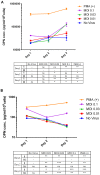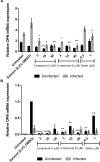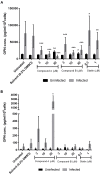Induction of Osteopontin by Dengue Virus-3 Infection in THP-1 Cells: Inhibition of the Synthesis by Brefelamide and Its Derivative
- PMID: 28405192
- PMCID: PMC5370276
- DOI: 10.3389/fmicb.2017.00521
Induction of Osteopontin by Dengue Virus-3 Infection in THP-1 Cells: Inhibition of the Synthesis by Brefelamide and Its Derivative
Abstract
Osteopontin (OPN) is a multifunctional matricellular protein produced by a broad range of cells including osteoclasts, macrophages, T cells, endothelial cells, and vascular smooth muscle cells. OPN modulates various physiological and pathological events such as inflammation, wound healing, and bone formation and remodeling. Dengue virus (DENV) infection causes an increase in plasma OPN levels, which is correlated with the severity of symptoms and coagulation abnormalities. DENV infection also induces OPN gene expression in human macrophages. This study investigated the inhibitory effects of brefelamide and its methyl ether derivative on DENV-3 by measuring changes in OPN levels in human THP-1 and 293T cell lines infected at different multiplicities of infection and post-infection time points. OPN mRNA expression and viral RNA were detected by reverse transcriptase quantitative real-time PCR, whereas protein level was determined by enzyme-linked immunosorbent assay. We found that viral copy number was higher in 293T than in THP-1 cells. However, THP-1 constitutively expressed higher levels of OPN mRNA and protein, which were enhanced by DENV-3 infection. Brefelamide and its derivative suppressed OPN production in DENV-3 infected THP-1 cells; the effective doses of these compounds had no effect on uninfected cells, indicating low cytotoxicity. These results suggest that brefelamide and its methyl ether derivative have therapeutic effects in preventing inflammation, coagulopathy, and fibrinolysis caused by OPN upregulation induced by DENV-3 infection.
Keywords: 293T cell; THP-1 cell; brefelamide; dengue virus-3; osteopontin.
Figures






Similar articles
-
Elevated levels of full-length and thrombin-cleaved osteopontin during acute dengue virus infection are associated with coagulation abnormalities.Thromb Res. 2014 Aug;134(2):449-54. doi: 10.1016/j.thromres.2014.05.003. Epub 2014 May 14. Thromb Res. 2014. PMID: 24861695 Free PMC article.
-
Upregulation of osteopontin expression via the interaction of macrophages and fibroblasts under IL-1b stimulation.Cytokine. 2018 Oct;110:63-69. doi: 10.1016/j.cyto.2018.04.025. Epub 2018 Apr 25. Cytokine. 2018. PMID: 29704820
-
Identification of brefelamide as a novel inhibitor of osteopontin that suppresses invasion of A549 lung cancer cells.Oncol Rep. 2016 Oct;36(4):2357-64. doi: 10.3892/or.2016.5006. Epub 2016 Aug 5. Oncol Rep. 2016. PMID: 27498705
-
Osteopontin is essential for IL-1β production and apoptosis in peri-implantitis.Clin Implant Dent Relat Res. 2018 Jun;20(3):384-392. doi: 10.1111/cid.12592. Epub 2018 Feb 15. Clin Implant Dent Relat Res. 2018. PMID: 29446213
-
Osteopontin: A Promising Therapeutic Target in Cardiac Fibrosis.Cells. 2019 Dec 3;8(12):1558. doi: 10.3390/cells8121558. Cells. 2019. PMID: 31816901 Free PMC article. Review.
Cited by
-
Elevated Levels of Galectin-9 but Not Osteopontin in HIV and Tuberculosis Infections Indicate Their Roles in Detecting MTB Infection in HIV Infected Individuals.Front Microbiol. 2020 Jul 17;11:1685. doi: 10.3389/fmicb.2020.01685. eCollection 2020. Front Microbiol. 2020. PMID: 32765475 Free PMC article.
-
The Roles of Matricellular Proteins in Oncogenic Virus-Induced Cancers and Their Potential Utilities as Therapeutic Targets.Int J Mol Sci. 2017 Oct 21;18(10):2198. doi: 10.3390/ijms18102198. Int J Mol Sci. 2017. PMID: 29065446 Free PMC article. Review.
-
Osteopontin aggravates acute lung injury in influenza virus infection by promoting macrophages necroptosis.Cell Death Discov. 2022 Mar 4;8(1):97. doi: 10.1038/s41420-022-00904-x. Cell Death Discov. 2022. PMID: 35246529 Free PMC article.
-
Short communication: Feasibility of dengue vaccine to infect different human cell lines: An alternative potency test using HEK293T cells.PLoS One. 2022 May 6;17(5):e0267653. doi: 10.1371/journal.pone.0267653. eCollection 2022. PLoS One. 2022. PMID: 35522661 Free PMC article.
-
Mechanistic insights into bone remodelling dysregulation by human viral pathogens.Nat Microbiol. 2024 Feb;9(2):322-335. doi: 10.1038/s41564-023-01586-6. Epub 2024 Feb 5. Nat Microbiol. 2024. PMID: 38316931 Free PMC article. Review.
References
-
- Avirutnan P., Malasit P., Seliger B., Bhakdi S., Husmann M. (1998). Dengue virus infection of human endothelial cells leads to chemokine production, complement activation, and apoptosis. J. Immunol. 161 6338–6346. - PubMed
LinkOut - more resources
Full Text Sources
Other Literature Sources
Research Materials

